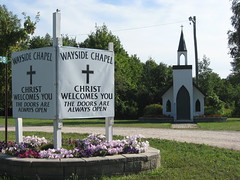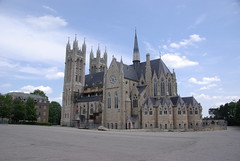
A good portion of my life was spent in Oklahoma City and the surrounding communities (the first 22 years, in fact). However, in all that time I only attended two churches—
Sunnyside Baptist Church, and, once I was in college,
Hazel Dell Baptist, where I was the pianist/youth pastor with Amy/church secretary/lawncare guy. I was happy to explore some of the churches in the area while home visiting family, for while I had driven by many, I had been in only a few. The sad truth of Oklahoma City is, that while there's often more than one church per block, most were built with no concept of architectural significance. Currently, there are more megachurches than I can count in the area, all of whom either have huge, cavernous spaces pointed to a stage/screen, or are converted stores (one used to be Wal-Mart), or both. But besides these new, huge structures, since Oklahoma just last year celebrated its centennial, most of the churches were built in the modernist period of architecture, or, even more likely, just in the simplest manner possible.
However, I did find some gems in the area (if you're in Oklahoma City and want to see them, I mapped them on
Flickr). I haven't hit them all yet, but I got a good start. Firstly, I did have a
San Marco at the church I grew up in,
Sunnyside. The building fascinates me, mostly because I know the pastor who was instrumental in building it. Harry Boydstun, who was the pastor for much of my life, helped to build the current building in 1962. He was a fire and brimstone preacher, focusing so much on the law that I grew up utterly terrified of God. The building reflects his focus, for, rather than crosses in the
sanctuary, there were lots of images of the
Word. The only crosses were these two small ones on the
communion table, which was interestingly hidden under a projector screen while I was there. The
stained glass lining the nave was only abstract shapes, but the stained glass over the
baptistry (which was hidden behind the projector screen) was an image of the
Ten Commandments. While the church is an obvious product of the early 60s, in its defense is an interesting
steeple, and, the sense of space provided by the high ceiling in the sanctuary.
I further received a
Gaudi at one of the older downtown church buildings, what is now
Citychurch. After wandering in the open door, one of the staff evangelists started talking to me, and then took me on a tour. Built in 1911 as the
First Christian Church, the building is neoclassical, or, perhaps more correctly,
Beaux-Arts, in its style (much like the bottom of the nearby
Old Post Office). It was bought in the early 90s by Citychurch, a charismatic congregation, and, after sitting dormant for over 30 years, is again a thriving church. The building has a wonderful tin
dome along with four smaller ones. The dome received some damage in the 1995 Murrah Building Bombing, but its
interior and exterior are still original. The sanctuary itself shows the theater style that had become popular in churches, with a
curved balcony around the pulpit. Most interesting in the sanctuary was the huge stained glass cross, seen from
below and
above, as well as in its
context. The pews had been long removed from the
nave, as had the large pipe organ from behind the
pulpit. It did make me happy to see what was once a derelict building again a vibrant Christian community.
A
Truro was mine at
St. Paul's Episcopal Cathedral. The dean, the Very Reverend George H. Back, let me in and pointed out some notable features, but then he left me to shoot as he was off to lunch. Built in 1904, it's
a Gothic church, albeit a simple one. It received even heavier damage from the 1995 bombing, but has been
well-restored. It is not a large cathedral, as seen in
this shot from the back of the nave. The altar area is nice, with two
Tiffany windows, as well as a lovely Gothic
altar. The balcony is taken up by the
organ (which sounds fabulous—I worshiped here on Palm Sunday a couple of years ago). The
pulpit, altar and
font (as well as some columns) are all made of the same stone, which I believe Rev. Back said was Oklahoma granite. Its simplicity is appropriate for the time it was built, when Oklahoma City was barely a stop in the prairie.
The
First Presbyterian Church gave me one more Truro. It fascinates me, for it was the only
cruciform church I found (except for a chapel at a local Catholic school—but it was in the school's closed grounds). Built in the
Gothic style, it was actually built in 1962—the same time as Sunnyside. Most notable in the church are its
stained glass windows and its
organ, a
Mohler. The
Rose window above the East transept (like most of the churches I went to, the altar is on the North) is a picture of notable women of the Bible. Further, there is a
chapel attached that could be a church itself. I find this Gothic church interesting, in that it was built in only a couple of years. The stonework is not as good as others I've seen, although I couldn't quite place my finger on the reason. It felt more nostalgic than anything else. It was still a good example of a cruciform Gothic church, and unexpected in a city which was largely built after the Gothic revival.
Two
Colognes were mine, at
Old St. Joseph's Cathedral and the
First Lutheran Church. Old St. Joseph's was the Roman Catholic Cathedral from 1903-1925. It seems like a pretty
light brick
Gothic. Its
altar was not too ornate, although nice. The
nave was made up of
ribbed vaults (or, perhaps they were just painted on). First Lutheran's
altar looks like its been altered through the years, with, among other things, fluorescent lights surrounding it. Its
stained glass fascinated me because
it looks so similar to the stained glass in Citychurch, above, and First Baptist, below—built in 1912, 1911 and 1910 respectively. The lights along the nave were
trinitarian in shape, although also fluorescent. Its
communion tables intrigued me, as they look like you actually sit at table to receive communion.
I also had three
Chartres, at
First Methodist Church,
First Baptist Church, and at the new Roman Catholic Cathedral,
Our Lady of Perpetual Help. And, finally, some Toulouse, at
St. Francis of Assisi,
Little Flower, and, not to be forgotten,
Calvary Baptist Church. The next time I'm home, I hope to hit some of the other interesting churches. These were most of the older ones, but there are some truly creative architectural examples from later periods.

















